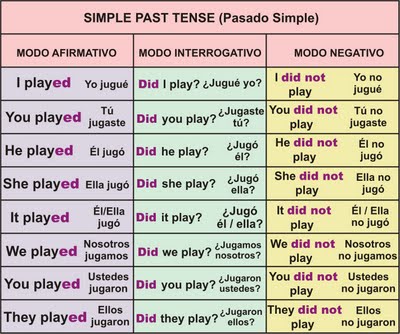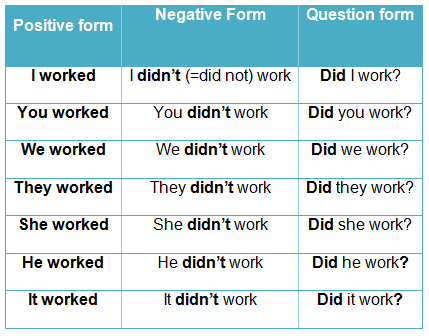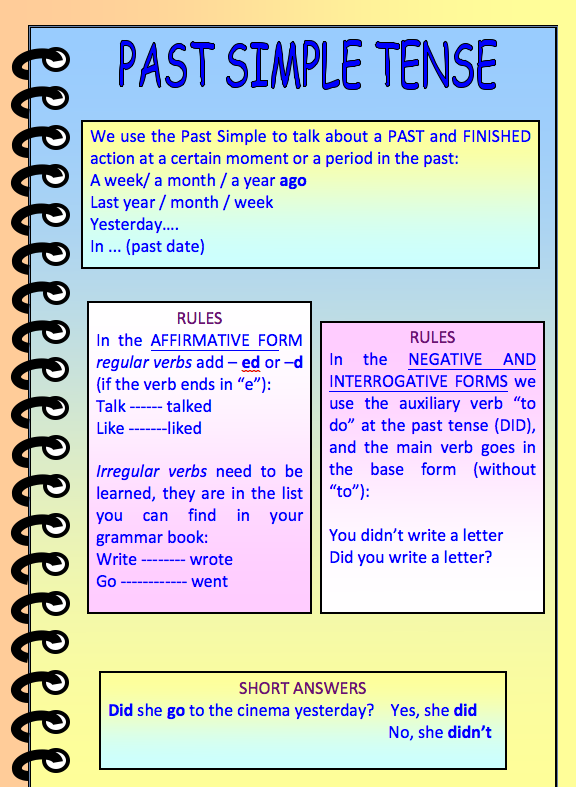Idioma Past Simple (Pasado simple) & Past contiuous (Pasado continuo)
-
AutoBanned

 Past Simple (Pasado simple) & Past contiuous (Pasado continuo)
Past Simple (Pasado simple) & Past contiuous (Pasado continuo)
Past Simple (Pasado simple)
Hay muchas maneras de hablar del pasado en inglés, pero el pasado simple es la forma más común. El pasado simple en inglés es equivalente al pretérito imperfecto y pretérito indefinido del español. Usamos el pasado simple para acciones completas en el pasado. El período de tiempo de estas acciones no es importante como en el español. En el pasado simple hay verbos regulares y verbos irregulares.
Grammatical Rules (Reglas gramaticales)
Form (Forma)
Para formar el pasado simple con verbos regulares, añadimos la terminación "-ed" al verbo. La forma es la misma para todas las personas (I, you, he, she, it, we, they).
Ejemplos:
want → wanted
learn →learned
stay →stayed
walk →walked
Excepciones:
Para verbos que terminan en una "e", sólo añadimos "-d.
Ejemplos:
change → changed
believe →believed
Si el verbo termina en una vocal corta y una consonante (excepto "y" o "w"), doblamos la consonante final.
Ejemplos:
stop → stopped
commit → committed
Con verbos que terminan en una consonante y una "y", se cambia la "y" por una "i".
Ejemplos:
study →studied
try →tried
Nota: Hay muchos verbos irregulares en inglés. Desafortunadamente, no hay una norma establecida para formarlos. A continuación tienes los tres verbos irregulares más comunes y los que actúan como verbos auxiliares.
Verb Past Simple
be was (I, he, she, it) / were (you, we, they)
do did
have had
Pronunciation (Pronunciación)
Pronunciamos la terminación "-ed" de forma diferente dependiendo de la letra que va al final del infinitivo. En general la "e" es muda.
Con los infinitivos que terminan en "p", "f", "k" o "s" (consonantes sordas, excepto "t") pronunciamos la terminación" "-ed" como una "t".
Ejemplos:
looked
kissed
Con los infinitivos que terminan en "b", "g", "l", "m", "n", "v", "z" (consonantes sonoras, excepto "d") o una vocal, pronunciamos sólo la "d".
Ejemplos:
yelled
cleaned
Con los infinitivos que terminan en "d" o "t", pronunciamos la "e" como una "i".
Ejemplos:
ended
waited
1. Affirmative Sentences (Frases afirmativas)
Sujeto + verbo principal...
Ejemplos:
The keys were in the drawer. (Las llaves estaban en el cajón.)
I wanted to dance. (Quería bailar.)
He learned English. (Aprendió inglés.)
They believed him. (Le creímos.)
2. Negative Sentences (Frases negativas)
To be:
Sujeto + "to be" + "not"...
Ejemplos:
She wasn't a doctor. (Ella no era doctora.)
The keys weren't in the drawer. (Las llaves no estaban en el cajón.)
Nota: El verbo "to have got", que en el presente simple sigue las mismas reglas que el verbo "to be", no puede ser utilizado en el pasado. Para indicar la posesión en el pasado, usamos el verbo "to have".
Todos los demás verbos:
Sujeto + verbo auxiliar ("to do") + "not" + verbo principal...
Ejemplos:
I didn't want to dance. (No quería bailar.)
He didn't learn English. (No aprendió inglés)
They didn't believe him. (No le creímos.)
Nota: En frases negativas, el verbo auxiliar va en pasado ("did") y el verbo principal se queda en el infinitivo.
3. Interrogative Sentences (Frases interrogativas)
To be:
"To be" + sujeto...?
Ejemplos:
PlayWas she a doctor? (¿Ella era doctora?)
Play Were the keys in the drawer? (¿Estaban las llaves en el cajón?)
Todos los verbos demás:
Verbo auxiliar ("to do") + sujeto + verbo principal...?
Ejemplos:
Did you want to dance? (¿Querías bailar?)
Did he learn English? (¿Aprendió inglés?)
Did they believe him? (¿Le creíste?)
Nota: Al igual que en las frases negativas, el verbo auxiliar va en pasado ("did") y el verbo principal se queda en el infinitivo.
Uses (Usos)
El pasado simple se utiliza para hablar de una acción concreta que comenzó y acabó en el pasado. En este caso equivale al pretérito indefinido español. Generalmente, lo usamos con adverbios de tiempo como "last year", "yesterday", "last night"...
Ejemplos:
Tom stayed at home last night. (Tom se quedó en casa anoche.)
Kate worked last Saturday. (Kate trabajó el sábado pasado.)
I didn't go to the party yesterday. (No fui a la fiesta ayer.)
Did they walk to school this morning? (¿Han andado a la escuela esta mañana?)
Se usa el pasado simple para un serie de acciones en el pasado.
Ejemplos:
I received the good news and immediately called my husband. (Recibí la buena noticia y llamé de inmediato a mi marido.)
He studied for an hour in the morning, worked all afternoon and didn't return home until 10 at night. (Estudió durante una hora por la mañana, trabajó toda la tarde y no regresó a casa hasta las 10 de la noche.)
También lo usamos para acciones repetidas o habituales en el pasado, como se usa el pretérito imperfecto español.
Ejemplos:
We always traveled to Cancun for vacation when we were young. (Siempre viajábamos a Cancun durante las vacaciones cuando éramos jóvenes.)
He walked 5 kilometers every day to work. (Caminaba 5 kilómetros hasta el trabajo cada día.)
Lo usamos para narraciones o acciones de períodos de largo tiempo en el pasado, como el pretérito imperfecto español.
Ejemplos:
She didn't eat meat for 6 years. (No comía carne durante 6 años.)
Se utiliza para hablar de generalidades o hechos del pasado.
Ejemplos:
The Aztec lived in Mexico. (Los aztecas vivían en México)
I played the guitar when I was a child. (Tocaba la guitarra cuando era niño.)




%20contrast.png/487468350/simplepastandcontinuous(sppc)%20contrast.png)
VERBOS IRREGULARES O NO REGULARES

Past contiuous (Pasado continuo)
[was/were + present participle]

How do we use the Past Continuous Tense?
The Past Continuous tense expresses action at a particular moment in the past. The action started before that moment but has not finished at that moment. For example, yesterday I watched a film on TV. The film started at 7pm and finished at 9pm.
At 8pm yesterday, I was watching TV.
At 8pm, I was in the middle of watching TV.
When we use the Past Continuous tense, our listener usually knows or understands what time we are talking about. Look at these examples:
I was working at 10pm last night.
They were not playing football at 9am this morning.
What were you doing at 10pm last night?
What were you doing when he arrived?
She was cooking when I telephoned her.
We were having dinner when it started to rain.
Ram went home early because it was snowing.
Note that some verbs cannot be used in continuous/progressive tenses.
We often use the Past Continuous tense to "set the scene" in stories. We use it to describe the background situation at the moment when the action begins. Often, the story starts with the Past Continuous tense and then moves into the Past Simple tense. Here is an example:
"James Bond was driving through town. It was raining. The wind was blowing hard. Nobody was walking in the streets. Suddenly, Bond saw the killer in a telephone box..."
Past Continuous + Past Simple
We often use the Past Continuous tense with the Past Simple tense. We use the Past Continuous to express a long action. And we use the Past Simple to express a short action that happens in the middle of the long action. We can join the two ideas with when or while.
In the following example, we have two actions:
long action (watching TV), expressed with Past Continuous
short action (telephoned), expressed with Past Simple
past present future
long action:
I was watching TV from 7pm to 9pm.
8pm
short action:
You phoned at 8pm.
We can join these two actions with when:
I was watching TV when you telephoned.
Notice that "when you telephoned" is also a way of defining the time (8pm).
We use:
when + short action (Past Simple)
while + long action (Past Continuous)
There are four basic combinations:
I was walking past the car when it exploded.
When the car exploded I was walking past it.
The car exploded while I was walking past it.
While I was walking past the car it exploded.
Notice that the long action and short action are relative.
"Watching TV" took two hours. "Telephoned" took a few seconds.
"Walking past the car" took a few seconds. "Exploded" took milliseconds.
Used To (solía)(otra forma de pasado)
[used to + VERB]
Example:
I used to go to the beach every day.
It is better not to use "used to" in questions or negative forms; however, this is sometimes done in informal spoken English. It is better to ask questions and create negative sentences using Simple Past.
USE 1 Habit in the Past
"Used to" expresses the idea that something was an old habit that stopped in the past. It indicates that something was often repeated in the past, but it is not usually done now.
Examples:
Jerry used to study English.
Sam and Mary used to go to Mexico in the summer.
I used to start work at 9 o'clock.
Christine used to eat meat, but now she is a vegetarian.
USE 2 Past Facts and Generalizations
"Used to" can also be used to talk about past facts or generalizations which are no longer true.
Examples:
I used to live in Paris.
Sarah used to be fat, but now she is thin.
George used to be the best student in class, but now Lena is the best.
Oranges used to cost very little in Florida, but now they are quite expensive.
"Used to" vs. Simple Past
Both Simple Past and "Used to" can be used to describe past habits, past facts and past generalizations; however, "used to" is preferred when emphasizing these forms of past repetition in positive sentences. On the other hand, when asking questions or making negative sentences, Simple Past is preferred.
Examples:
You used to play the piano.
Did you play the piano when you were young?
You did not play the piano when you were young
 Permisos de publicación
Permisos de publicación
- No puedes crear nuevos temas
- No puedes responder temas
- No puedes subir archivos adjuntos
- No puedes editar tus mensajes
-
Reglas del foro
▲
▼
Atajos de Navegación Disponibles